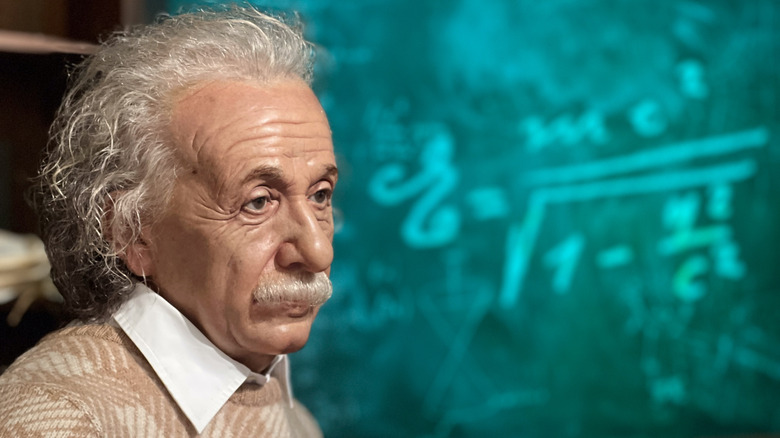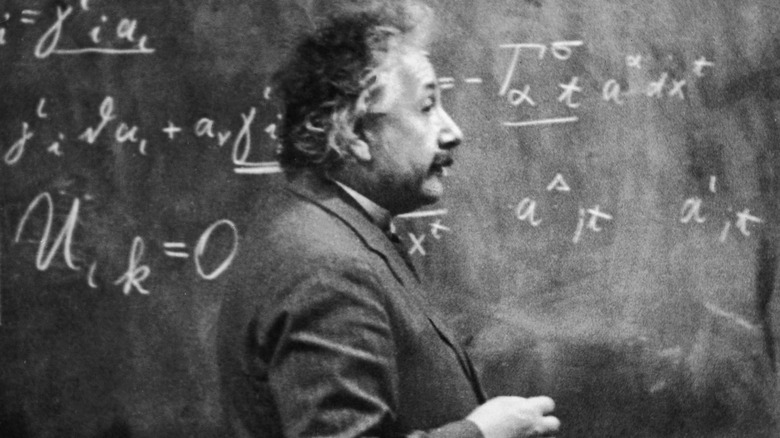The Grand Problem That Stumped Einstein And Still Baffles Physicists Today
The grand problem that Einstein struggled with in his later years, after publishing his breakthrough works on relativity, is a problem that remains unsolved. We're talking, of course, about the elusive "Grand Theory of Everything." Attempts to resolve Einsteinian physics with quantum mechanics has persisted for a century, yet every effort has failed. The two conflicting models have been haunting physicists for decades. Both theories are testable, with countless experiments proving their veracity. Yet, both remain incompatible.
Einstein's theories of relativity basically describe the nature of gravity as a bending of space-time, while quantum mechanics describes all the forces of nature as quantum probabilities. Both theories work exceptionally well — just not with each other.
The field of quantum mechanics has theoretically and experimentally defined three out of four of the fundamental forces of nature. Thanks to high-tech tools like particle accelerators, physicists have used quantum theory to describe electromagnetism, the weak force, and the strong force in terms of particles and probability. Yet gravity remains the enigma.
It was gravity that stumped Einstein, as he tried to reconcile his theories with the field of quantum mechanics that was blooming in his later years. Finding a glorious, unifying theory became something of an obsession, and his efforts may have even alienated him from the mainstream scientific community — a community that was making great strides in quantum mechanics. With every new breakthrough in quantum theory, the rift between Einsteinian gravity and quantum mechanics grew wider.
Evidence of Einstein's struggles
In 2006, an archive of 33 letters and 15 manuscripts between Einstein and his contemporaries was sold for a cool $1 million. The documents were written from 1933 to 1954, a period in which the already-famous physicist expressed his attempts (and frustrations) to describe a "grand theory of everything." The buyer of the papers wasn't made public, but some of the content of the literature was.
We know who sold the archive, however. The collection was compiled and sold in 2006 by the family estate of Ernst Gabor Straus. Straus was one of Einstein's closest partners and academic assistants, and a person who had an undeniably profound influence on Einstein's research of the period. The documents may not reveal a theory of everything, but they do strengthen the image of Einstein as a brilliant man who stood on the shoulders of giants.
This period in Einstein's career, spent at Princeton University in New Jersey, also reveals a humble, honest man who listened to other brilliant physicists and considered their input. Letters and accounts from colleagues like Straus suggest that Einstein had spent countless hours pursuing theoretical avenues that all led to dead ends. Each step of the way, Einstein collaborated with Straus and others in his unfruitful pursuit.
In fact, Straus often pointed out many of the faults in Einstein's lines of inquiry regarding the Grand Unifying Theory. And it seems that Straus was right to do so. The theory was never discovered, and Albert Einstein died in 1955, his dream of unifying modern physics into a single framework still unrealized to this day. It wasn't the only problem that stumped Einstein, but it was certainly one of the most important.
The current state of Einstein's unsolved problem
The theory of everything remains unsolved, though both the theory of gravity and quantum mechanics have been greatly refined since Einstein's death in 1955. While Einstein strove (and failed) to combine the four fundamental forces into a single unified field, three out of the four have been successfully combined thanks to advancements in theoretical and experimental physics.
Starting in the 1970s, breakthroughs in theoretical and experimental physics have defined the electromagnetic force, the strong nuclear force, and the weak nuclear force in a combined field theory. The final step in discovering a theory of everything would be a quantum theory of gravity. And while the theory itself remains elusive, a big leap towards its discovery occurred in 2015, invigorating new hope for physicists.
Gravitational waves were long speculated to exist, but it was only on September 14th, 2015, when they were finally proven to exist. The measurement occurred at the Laser Interferometer Gravitational-Wave Observatory, assisted by the European Virgo Detector and dozens of both ground- and space-based telescopes. This massive undertaking succeeded in detecting an incredibly small ripple in spacetime, a ripple emanating from a 1.3-billion-year-old collision between black holes.
The precise measurement was one of many confirmations of Einstein's breakthroughs in physics, but it also added new insights into the nature of gravity and how it might be incorporated into a theory of everything. For physicists, waves and particles are basically the same, so describing gravity with the language of waves is a major stride towards a quantum theory of gravity. And if you can quantize gravity, you might just be able to put Einstein's greatest challenge to rest.


